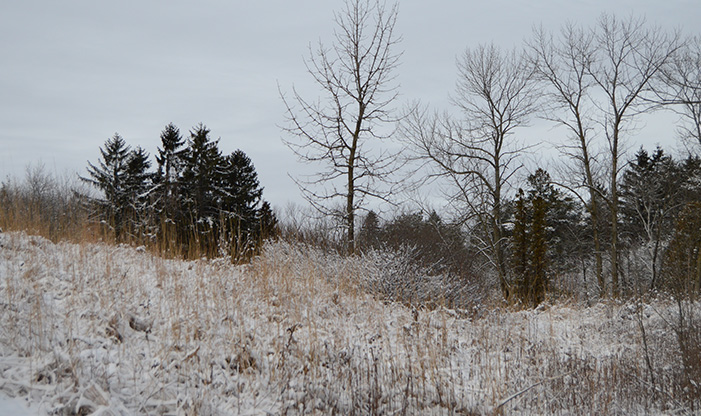When the days become their shortest and the temperature drops to its lowest, most animals (including us) take refuge in warmer places. So, what is out there for us to see in winter? Well, the trees and shrubs of course! Covered in snow, the gentle green giants of spring and summer become silent, braving the cold.
Trees come in all shapes and sizes, and are classified as having woody stems, one singular trunk, and being greater than six feet tall. During winter, we can see the skeletal twists and turns of the trunks down to the twigs without the interruption of leaves, so we use their bark, buds, and overall shape to find out which tree is which.
Quaking Aspen
To see our biggest quaking aspen stand, hike just outside the Visitor Center and look east past the stone bench. The quaking aspen gets its name from leaves that flutter in the wind. In winter, however, we identify these swaying beauties by focusing on their bark. The bottom of their trunk looks smooth and gray, like a cottonwood, but about halfway up the bark it switches, resembling a birch tree. Aspens will always be seen around other aspens. This is because they are all technically one organism. A group of aspens, or a stand, is connected by an extensive root system, making them one singular entity. The individual trees look different because of how they respond to the elements while growing. Walk north along the Central Wetlands Loop to see how far an aspen stand can stretch.
Bur Oak
If you continue on this loop, particularly by Molly’s Pond and Dragonfly Pond, you can’t miss our boisterous bur oaks. Bur oaks are also found in the West Meadows where they spread massive thick branches across the sky in the open prairie. Bur oaks are easy to spot because they live alone in the fields. They get their name from the cap on their acorn, which resembles a bur. Bur oak are so majestic because of their strong thick bark, which is fire resistant. They need to be able to withstand fire because healthy prairies burn about every four to five years. These burnings help new oaks to grow from acorns that would otherwise have been outcompeted for sunlight by the tall grasses around it.
Box Elder
Box elder trees live in low wetlands. You will find most of these sleepy fellows if you leave the Central Wetlands Loop and head down to Lake Michigan on the Lake Terrace Loop. To spot a box elder, look for a thick trunk that’s leaning to one side. They are often confused with willow trees, but they have much thicker branches. Box elders are actually cousins to the maples, and they release helicopter seeds that blow in the wind. In winter you can still occasionally see their seed bundles stuck to the tips of branches.
Winter is a wonderland, and you can visit all the wonders here at the Center. Take our Central Wetlands Loop, head to Lake Michigan, stroll through our prairies, or meander in our forests. Every stop at Schlitz Audubon will have something new or interesting to captivate you.


